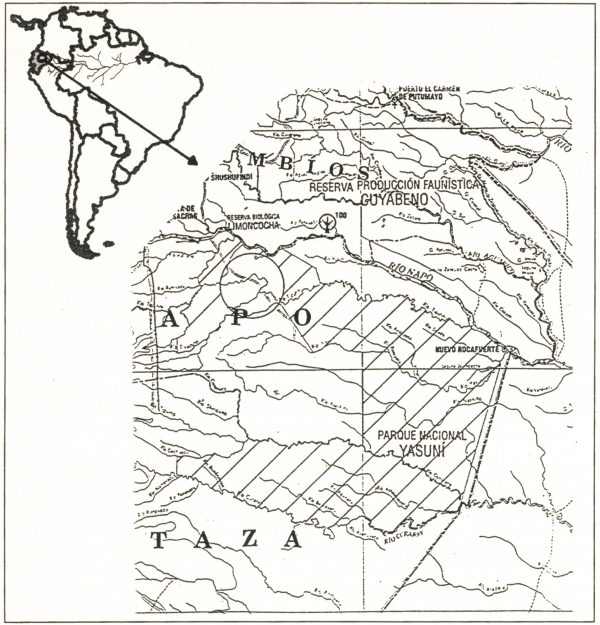 |
Last Update:
Thursday November 22, 2018
|
| [Home] |
STUDY ON THE ECOLOGY AND ETHOLOGICAL ASPECTS OF THE GIANT OTTER, Pteronura brasiliensis (Carnivora: Mustelidae) IN THE PARQUE NACIONAL YASUNÍ, ECUADOR (Start: April 1997) The Giant Otter was once widespread throughout the rainforest region of South America, but - due to irrational hunting and destruction of its habitat - its populations have drastically been reduced and now they are segregated to small secluded areas in their former home range. The status of the species is classified by IUCN as seriously endangered (Appendix 1 of CITES) The Parque Nacional Yasuní covers an area of 982.000 ha. It is situated in the Province of Napo and is the largest protected area in Ecuador. Its boundary in the north is formed by the river Napo and in the south by the river Curaray rising in the Anden mountain chain. The rivers Yasuní, Cononaco, Nashino and Tiputini flow through the Parque Nacional Yasuní. To date, very few investigations on the abundance and ecology of the Giant Otter have been carried out in the wild, and no study of this kind has been done in Ecuador. There are only occasional records of solitary animals or small groups, most of which have been registered in the Parque Nacional Yasuní. Considering that this species might soon be at the edge of extinction (or already is!), an investigation of the population size, its distribution and ecology is a matter of urgent necessity. The objectives of this project are:
The project will be carried out for a 12-month-period in order to get comparable data for the rainy (april to june) and for the dry season (December to March). Each month, 21 days will be spent for field work at the Parque Nacional Yasuní. METHODS 1. Determination Of The Distribution
All direct and indirect observations will be noted with a GPS, with the help of which it will be possible to give a topographically exact picture of the distribution. The number of observations will give an idea about the population size in this area. 2. Social Structure And Behaviour Data on the behaviour of the animals will be collected througout the day using binoculars, video and sound equipment to record the behaviour and calls. With the help of photo and video material, the animals will be identified according to the distinct patterns of their throat markings. This photo-identification will make it possible to recognize individuals, to determine the accurate number of animals in a group, and - eventually - to identify individual behaviours.
3. Analysis Of The Habitat The following water measurements will be taken every month at the beginning and end of each stay in the Park, in the rivers as well as in the oxbow lakes:
4. Diet Analysis Scats will be collected from all the latrines and analysized in detail at the laboratory in order to determine the diet composition and to detect toxic substances such as heavy metal pollution. Fish will be caught in the river for a later identificaton which will be done by specialists. The scales of the riverine fish will then be compared to the ones found in the scat to give an accurate account of the fish species in their diet. At the first trip in April 1997, a group of 5 Giant Otters was sighted and observed. First results of the project may be published in the next issue. Many thanks to Elke Staib and Christof Schenck for their support. SOUTH AMERICAN NETWORK FOR GIANT OTTERS The start of the Giant Otter project in Ecuador was connected with the proposal to establish a network for the conservation and protection of Giant Otters for whole South America. The aim of the network lies in the cooperation between organisations and scientists working on the protection of Giant Otter,
A cooperation in protection and conservation of Giant Otters might be the only way to prevent them from extinction. Organisations or scientists, interested in cooperation at the SOUTH AMERICAN NETWORK FOR GIANT OTTERS - SANGO may contact and send information about their work to: Christof Schenk/Elke Staib Riesenotterprojekt SANGO is a co-operative idea of Christof Schenk/Elke Staib and yaqu pacha. |
| [Copyright © 2006 - 2050 IUCN/SSC OSG] | [Home] | [Contact Us] |

